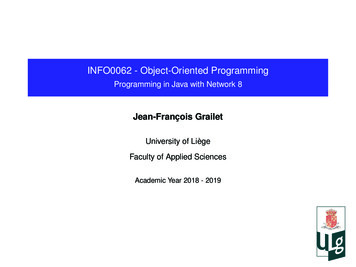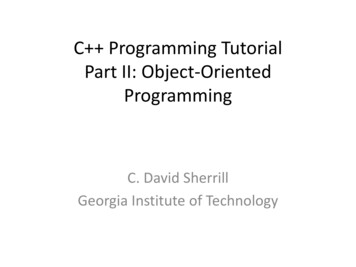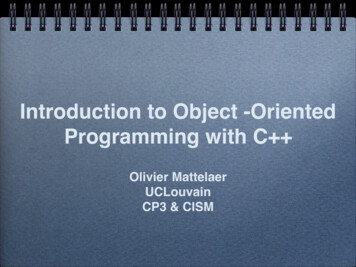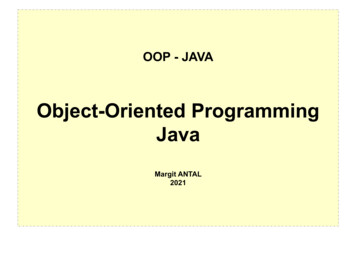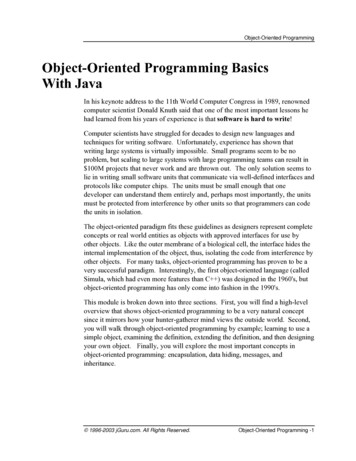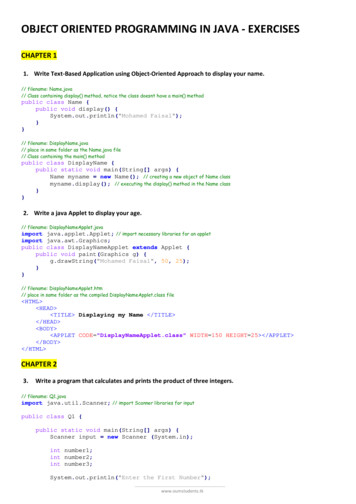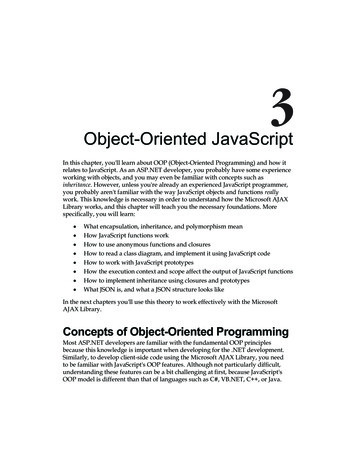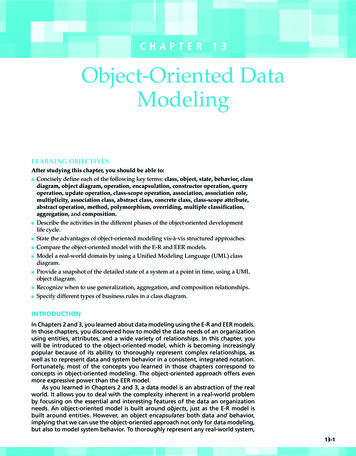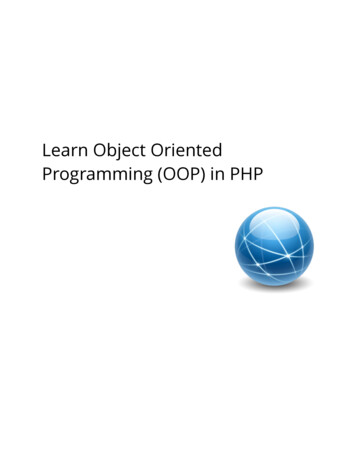
Transcription
!!!Learn Object OrientedProgramming (OOP) in PHP!!!!!!!!!!!
LEARN OBJECT ORIENTED PROGRAMMING (OOP) IN PHPPreambleThe hardest thing to learn (and teach btw,) in object oriented PHP is the basics.But once you get them under-your-belt, the rest will come much, much easier.But don't be discouraged! You just found the easiest to understand tutorial outthere on OOP and PHP. It may sound like a boastful claim I know. But that's whatthe nerd zeitgeist is saying. Or so I've been told.VideosAs an extra bonus, I've created a few video tutorials for you. They cover the samematerial as the written article and are designed to reinforce the article. Introduction to Object Oriented PHP (4:05) Why learn Object Oriented PHP (14:46) Objects and Classes in PHP (5:26) Build Objects in PHP - Part 1 (9:14) Build Objects in PHP - Part 2 (9:41) Build Objects in PHP - Part 3 (6:18)If you have questions/comments, you can contact me at: stefan@killersites.com!!!! 1996 - 2013 www.killerphp.com
LEARN OBJECT ORIENTED PROGRAMMING (OOP) IN PHPLearn Object Oriented Programming (OOP) in PHPObject-Oriented Programming (OOP) is a type of programming added to php5 thatmakes building complex, modular and reusable web applications that much easier.With the release of php5, php programmers finally had the power to code with the'big boys'. Like Java and C#, php finally has a complete OOP infrastructure.In this tutorial, you will be guided (step-by-step) through the process of building andworking with objects using php's built-in OOP capabilities. At the same time you willlearn: The difference between building a php application the old fashioned (procedural)way, versus the OOP way. What the basic OOP principles are, and how to use them in PHP. When you would want to use OOP in your PHP scripts.People run into confusion when programming because of some lack ofunderstanding of the basics. With this in mind, we are going to slowly go over keyOOP principles while creating our own PHP objects. With this knowledge, you willbe able to explore OOP further.For this tutorial, you should understand a few PHP basics: functions, variables,conditionals and loops.To make things easy, the tutorial is divided into 23 steps.!!!!! 1996 - 2013 www.killerphp.com
LEARN OBJECT ORIENTED PROGRAMMING (OOP) IN PHPSTEP 1:First thing we need to do is create two PHP pages: index.php class lib.phpOOP is all about creating modular code, so our object oriented PHP code will becontained in dedicated files that we will then insert into our normal PHP page usingphp 'includes'. In this case all our OO PHP code will be in the PHP file: class lib.phpOOP revolves around a construct called a 'class'. Classes are the cookie-cutters /templates that are used to define objects.!STEP 2: Create a PHP classInstead of having a bunch of functions, variables and code floating around willynilly, to design your php scripts or code libraries the OOP way, you'll need to define/create your own classes.You define your own class by starting with the keyword 'class' followed by the nameyou want to give your new class.1. ?php!2.class person {!3.!4.}!!!! 1996 - 2013 www.killerphp.com
LEARN OBJECT ORIENTED PROGRAMMING (OOP) IN PHPSTEP 3: Add data to your classClasses are the blueprints for php objects - more on that later. One of the bigdifferences between functions and classes is that a class contains both data(variables) and functions that form a package called an: 'object'. When you create avariable inside a class, it is called a 'property'.1. ?php!2.class person {!3.4.var name;!}!Note: The data/variables inside a class (ex: var name;) are called 'properties'.!STEP 4: Add functions/methods to your classIn the same way that variables get a different name when created inside a class(they are called: properties,) functions also referred to (by nerds) by a differentname when created inside a class - they are called 'methods'.A classes' methods are used to manipulate its' own data / properties.1. ?php!2.class person {!3.4.var name;!!5.function set name( new name) {!6.!! this- name new name;!7.!}!!8.!!9.!function get name() {!10. !!return this- name;!!!!! 1996 - 2013 www.killerphp.com
LEARN OBJECT ORIENTED PROGRAMMING (OOP) IN PHP11. !}!12. }!Note: Don't forget that in a class, variables are called 'properties'.!STEP 5: Getter and setter functionsWe've created two interesting functions/methods: get name() and set name().These methods follow a common OOP convention that you see in many languages(including Java and Ruby) - where you create methods to 'set' and 'get' properties ina class.Another convention (a naming convention,) is that getter and setter names shouldmatch the property names.1. ?php!2.class person {!3.4.var name;!!5.function set name( new name) {!6.!! this- name new name;!7.!}!!8.!!9.!function get name() {!10. !!return this- name;!!!!!11. !}!12. }!Note: Notice that the getter and setter names, match the associated propertyname. 1996 - 2013 www.killerphp.com
LEARN OBJECT ORIENTED PROGRAMMING (OOP) IN PHPThis way, when other PHP programmers want to use your objects, they will knowthat if you have a method/function called 'set name()', there will be a property/variable called 'name'.!STEP 6: The ' this' variableYou probably noticed this line of code: this- name new nameThe this is a built-in variable (built into all objects) which points to the currentobject. Or in other words, this is a special self-referencing variable. You use thisto access properties and to call other methods of the current class.1.function get name() {!2.!return this- name;!3.}!!Note: This may be a bit confusing for some of you that's because you are seeingfor the first time, one of those built in OO capabilities (built into PHP5 itself) thatautomatically does stuff for us.For now, just think of this as a special OO PHP keyword. When PHP comes across this, the PHP engine knows what to do. Hopefully soon, you will too!!STEP 7: Include your class in your main PHP pageYou would never create your PHP classes directly inside your main php pages - thatwould help defeat the purposes of object oriented PHP in the first place!Instead, it is always best practice to create separate php pages that only containyour classes. Then you would access your php objects/classes by including them inyour main php pages with either a php 'include' or 'require'.! 1996 - 2013 www.killerphp.com
LEARN OBJECT ORIENTED PROGRAMMING (OOP) IN PHP1. !DOCTYPE html !2. html !3.!4. head !5. meta charset "UTF-8" !6. title OOP in PHP /title !7.!8. ?php include("class lib.php"); ? !9.!10. /head !11.!12. body !13. /body !14.!15. /html !Note: Notice how we haven't done anything with our class yet. We will do that next.!STEP 8: Instantiate/create your objectClasses are the blueprints/templates of php objects. Classes don't actually becomeobjects until you do something called: instantiation.When you instantiate a class, you create an instance of it, thus creating the object.In other words, instantiation is the process of creating an instance of an object inmemory. What memory? The server's memory of course!1. ?php include("class lib.php"); ? !2. /head !3.!4. body ! 1996 - 2013 www.killerphp.com
LEARN OBJECT ORIENTED PROGRAMMING (OOP) IN PHP5. ?php!6. stefan new person();!7.? !8.!9. /body !10. /html !Note: The variable stefan becomes a handle/reference to our newly createdperson object. I call stefan a 'handle', because we will use stefan to control anduse the person object.If you run the PHP code now, you will not see anything displayed on your pages.The reason for this, is because we have not told PHP to do anything with the objectwe just created !STEP 9: The 'new' keywordTo create an object out of a class, you need to use the 'new' keyword.When creating/instantiating a class, you can optionally add brackets to the classname, as I did in the example below. To be clear, you can see in the code below howI can create multiple objects from the same class. From the PHP's engine point of view, each object is its' own entity. Does thatmake sense?1. ?php include("class lib.php"); ? !2. /head !3.!4. body !5. ?php!6. stefan new person();!7. jimmy new person();! 1996 - 2013 www.killerphp.com
LEARN OBJECT ORIENTED PROGRAMMING (OOP) IN PHP8.? !9. /body !10. /html !Note: When creating an object, be sure not to quote the class name. For example: stefan new 'person'; will get you an error.!STEP 10: Set an objects propertiesNow that we've created/instantiated our two separate 'person' objects, we can settheir properties using the methods (the setters) we created.Please keep in mind that though both our person objects ( stefan and nick) arebased on the same 'person' class, as far as php is concerned, they are totallydifferent objects.1. ?php include("class lib.php"); ? !2. /head !3.!4. body !5. ?php!6. stefan new person();!7. jimmy new person();!8.!9. stefan- set name("Stefan Mischook");!10. jimmy- set name("Nick Waddles");!11. ? !12.!13. /body !14. /html !! 1996 - 2013 www.killerphp.com
LEARN OBJECT ORIENTED PROGRAMMING (OOP) IN PHPSTEP 11: Accessing an object's dataNow we use the getter methods to access the data held in our objects this is thesame data we inserted into our objects using the setter methods.When accessing methods and properties of a class, you use the arrow (- ) operator.1. ?php include("class lib.php"); ? !2. /head !3.!4. body !5. ?php!6. stefan new person();!7. jimmy new person();!8.!9. stefan- set name("Stefan Mischook");!10. jimmy- set name("Nick Waddles");!11.!12.echo "Stefan's full name: " . stefan- get name();!13.echo "Nick's full name: " . jimmy- get name();!14. ? !15. /body !16. /html !Note: The arrow operator (- ) is not the same operator used with associativearrays: .Congratulations, you've made it half way through the tutorial! Time to take a littlebreak and have some tea OK, maybe some beer.In a short period of time, you've:! 1996 - 2013 www.killerphp.com
LEARN OBJECT ORIENTED PROGRAMMING (OOP) IN PHP Designed a PHP class. Generate/created a couple of objects based on your class. Inserted data into your objects. Retrieved data from your objects. Not bad for your first day on the OO PHP job.If you haven't already, now is a great time to write out the code and watch it inaction in your own PHP pages.!STEP 12: Directly accessing properties - don't do it!You don't have to use methods to access objects properties; you can directly get tothem using the arrow operator (- ) and the name of the variable.For example: with the property name (in object stefan,) you could get its' valuelike so: stefan- name.Though doable, it is considered bad practice to do it because it can lead to troubledown the road. You should use getter methods instead - more on that later.1. ?php include("class lib.php"); ? !2. /head !3.!4. body !5. ?php!6. stefan new person();!7. jimmy new person();!8.!9. stefan- set name("Stefan Mischook");!10. jimmy- set name("Nick Waddles");! 1996 - 2013 www.killerphp.com
LEARN OBJECT ORIENTED PROGRAMMING (OOP) IN PHP11.!12.// directly accessing properties in a class is a no-no.!13.echo "Stefan's full name: " . stefan- name;!14. ? !15. /body !16. /html !!STEP 13: ConstructorsAll objects can have a special built-in method called a 'constructor'. Constructorsallow you to initialize your object's properties (translation: give your propertiesvalues,) when you instantiate (create) an object.Note: If you create a construct() function (it is your choice,) PHP will automaticallycall the construct() method/function when you create an object from your class.The 'construct' method starts with two underscores ( ) and the word 'construct'.You 'feed' the constructor method by providing a list of arguments (like a function)after the class name.1. ?php!2.class person {!3.4.var name;!!5.function construct( persons name) {!6. this- name persons name;!7.8.9.}!!!function set name( new name) {!10.11. this- name new name;!!!}!! 1996 - 2013 www.killerphp.com!
LEARN OBJECT ORIENTED PROGRAMMING (OOP) IN PHP12. !!13.function get name() {! !14.!return this- name;!15.}!16. } !17. ? !!For the rest of this tutorial, I'm going to stop reminding you that: Functions methods Variables properties Since this is an OO PHP tutorial I will now use the OO terminology.!STEP 14: Create an object with a constructorNow that we've created a constructor method, we can provide a value for the name property when we create our person objects.For example: stefan new person("Stefan Mischook");This saves us from having to call the set name() method reducing the amount ofcode. Constructors are common and are used often in PHP, Java etc.1. ?php include("class lib.php"); ? !2. /head !3.!4. body !5. ?php!6. stefan new person("Stefan Mischook");!7.echo "Stefan's full name: " . stefan- get name();! 1996 - 2013 www.killerphp.com
LEARN OBJECT ORIENTED PROGRAMMING (OOP) IN PHP8.? !9. /body !10. /html !This is just a tiny example of how the mechanisms built into OO PHP can save youtime and reduce the amount of code you need to write. Less code means less bugs.!STEP 15: Restricting access to properties using 'access modifiers'One of the fundamental principles in OOP is 'encapsulation'. The idea is that youcreate cleaner better code, if you restrict access to the data structures (properties)in your objects.You restrict access to class properties using something called 'access modifiers'.There are 3 access modifiers: public private protectedPublic is the default modifier.1. ?php!2.class person {!3.var name;!4.public height;!5.protected social insurance;!6.private pinn number;!7.8.!function construct( persons name) {!9.10. this- name persons name;!}! 1996 - 2013 www.killerphp.com
LEARN OBJECT ORIENTED PROGRAMMING (OOP) IN PHP11. !!12.function set name( new name) {!13. this- name new name;!14.!!!}!!15. !!16.function get name() {! !17.!return thi
First thing we need to do is create two PHP pages: index.php class_lib.php OOP is all about creating modular code, so our object oriented PHP code will be contained in dedicated files that we will then insert into our normal PHP page using php 'includes'. In this case all our OO PHP code will be in the PHP file: class_lib.php


